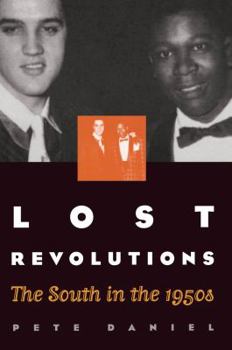Lost Revolutions: The South in the 1950s
Select Format
Select Condition 
Book Overview
This sweeping work of cultural history explores a time of startling turbulence and change in the South, years that have often been dismissed as placid and dull. In the wake of World War II, southerners anticipated a peaceful and prosperous future, but as Pete Daniel demonstrates, the road into the 1950s took some unexpected turns.
Daniel chronicles the myriad forces that turned the world southerners had known upside down in the postwar period...
Format:Paperback
Language:English
ISBN:0807848484
ISBN13:9780807848487
Release Date:April 2000
Publisher:University of North Carolina Press
Length:392 Pages
Weight:1.87 lbs.
Dimensions:0.9" x 6.1" x 9.3"
Customer Reviews
2 ratings
A look at Southern Culture in the 1950's
Published by Thriftbooks.com User , 17 years ago
Read this for graduate American history course. Lost Revolutions by Pete Daniel is a book that looks at the South during the 1950's. More specifically, it is a cultural history of the American South from the end of World War II until the Freedom Summer of 1964. Daniel's thesis is, "The South that evolved in the twenty years after the war emerged out of displacement, conflict, and creativity - not tranquility" (1). Daniel covers many themes that support his thesis. Among these themes are the migration of small farmers to cities, the advent of NASCAR, Rock n' Roll, and the lost occasions to give full citizenship to African Americans. The author's intention for writing this book is twofold. First, Daniel explores the cultural achievements of the "Lowdown culture" (91). He does this by looking at how the displaced farmers kept their rural roots, despite the fact that they lived in urban areas. Second, Daniel delves into the reasons why the middle-class and upper-class South did not want to desegregate. Lost Revolutions is a fascinating cultural history that sheds light on many current issues. Daniel discusses numerous issues that surrounded the South after the end of World War II. Primarily, the author looks at a multitude of reasons that massively shrank the number of farmers in the South. "Over a million farm operators left the land in the 1950s" (60). Ezra Taft Benson was a major contributor in the displacement of small farmers in the South. Benson was appointed the secretary of agriculture under Eisenhower in 1952. This is about the same time that farm machinery, such as tractors, began to replace labor-intensive farming techniques. Additionally, since the Great Depression the majority of southern farmers relied on Government subsidies. "Calculations, allotments, and regulations - not hard work - determined whether farmers succeeded or failed" (46). In 1959 a seventy-one-year-old Alabama farmer named E. Spech said, " ... now we can't move without a handout ... Each morning the men headed for some local restaurant for a cup of coffee while their wives sleep till noon" (59). It was obvious to many that Benson did not want to support the small farmer, but rather Agribusiness and the large farmer. Many of the white southern landowners bought more farms, machinery, and became wealthy with the support of the government. Conversely, small farmers, tenant farmers, and sharecroppers, both black and white, left their farms for the cities. One of the themes that Daniel discusses in Lost Revolutions is the role of the government on the southern environment. As machinery cut down on the need for workers on a farm, so to did the use of chemicals. Interestingly, after World War One, two the United States Department of Agriculture (USDA) teamed up with the Chemical Warfare Service to combine their chemical research. These organizations researched chemicals like DDT, which could be used against humans or insects to shut down the nervous system. DDT and ot
Excellent appraisal of the Southern paradox
Published by Thriftbooks.com User , 24 years ago
The 1950's South was both a time and a place of contradictions. On the one hand, there was a cultural revolution going on that fused both white and black musical tastes into one revolutionary music genre (rock 'n' roll) and a political revolution that went on (integration) which made the cultural achievements seem to pale in comparison. In essence, the South of the 1950's was a confusing maelstrom of contradictory policies and failed opportunities for peaceful change.So argues Pete Daniel in his book "Lost Revolutions: The South in the 1950's". Daniel's thesis is that the South offered ripe opportunities for change during the immediate post-World War II era but these opportunities were overlooked by the fact that warring factions between African-Americans and whites prevented to make important cultural revolutions make a difference in the political spectrum. These important cultural revolutions consisted of: the importance of rhythm and blues in forging feelings of appreciation between blacks and white country and western singers, the rise of NASCAR as a unifying factor among lower-class whites to challeng the hegemony of the white middle and upper-classes, and, finally, the rebeliousness exhibited by both white and black youth to forge a new consensus for political change. Daniel's book does an excellent job of explaining both why there were contradictions in Southern society and how these contradictions contributed to a painfully fought battle for integration and equal rights. This is a battle which is still being fought today but more on a state's rights and regionalistic front than a racial front.Daniel's book is a true lesson in primary source research and his endnotes clearly demonstrate this. Interviews, 4 pages of manuscript collection sources, and numerous prominent secondary sources fully back up a thought-provoking thesis. This book is a welcome addition to southern historiography.





